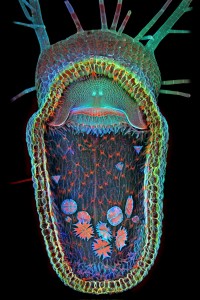This is an awesome picture, colorful with many intricate elements: cells that hang like bells, or Christmas decoration… It looks to me like the throat of some animal but it’s the trap of a bladderwort, a rootless plant that supplements its nutrition by trapping and digesting small animals. Shown inside the dome-shaped trap are green algae that are residents, and some tiny animals being ingested, all color-vivid by the use of a special fluorescent dye, and magnified 100 times under the microscope.
This image: Dr. Igor Siwanowicz, First Prize, 2013 Olympus BioScapes Digital Imaging Competition®.
Olympus BioScapes Digital Imaging Competition is an annual event by the camera maker and is open to all. The competition is judged by the following criteria (per its website):
Science – Uniqueness of the specimen or processes shown, importance of work, new information revealed, “story” told.
Aesthetics – Beauty or impact of the image, balance, composition.
Technical merit – Challenge of specimen itself – difficulty of capturing structures or data shown, photographic excellence.
These are exactly the criteria one would use to judge an artwork: uniqueness, story told, composition, technique… Etc.
Now the other picture: Henri Matisse’s The Joy of Life (Le Bonheur de Vivre, 1905-06). It also shows a cave-like opening – here in a forest – teeming with life.
What really does make the two different? Perhaps the lack of uncertainty in the bladderwort picture. *
* Science, at its core, acknowledges uncertainty: from quantum state to the vagaries of evolution. It is the scientific method that must be certain, being repeatable independently by others, which is exactly what art is not, and cannot be.

